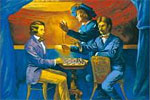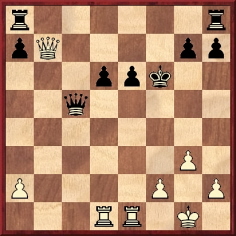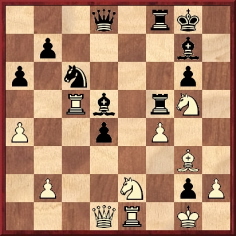Chess Explorations (46)
By Edward Winter
‘The most famous game of all time’ was the heading used by Frank Marshall on page 54 of Comparative Chess (Philadelphia, 1932) to describe Morphy against the Duke and Count, Paris, 1858 (1 e4 e5 2 Nf3 d6 3 d4 Bg4 4 dxe5 Bxf3 5 Qxf3 dxe5 6 Bc4 Nf6 7 Qb3 Qe7 8 Nc3 c6 9 Bg5 b5 10 Nxb5 cxb5 11 Bxb5+ Nbd7 12 O-O-O Rd8 13 Rxd7 Rxd7 14 Rd1 Qe6 15 Bxd7+ Nxd7 16 Qb8+ Nxb8 17 Rd8 mate).

Paul Charles Morphy
As noted on page 148 of A Chess Omnibus, there is no consensus among today’s masters about the game. In C.N. 2287 Yasser Seirawan (Amsterdam) informed us:
‘Regarding the best game of chess ever played, certainly none of my own games spring to mind. Morphy v the Duke and Count is arguably the most quoted game of all time and has much that is special about it. It is fair to say that no other game has brought so much pleasure to so many. The best game of chess ever played? Can there be such a thing? Would a perfect game not be boring? Can a mere off-hand game be the best ever? I don’t know the answers and, in spite of the questions, Morphy v the Duke and Count gets my vote.’
A contrasting view was expressed by John Nunn on pages 4-5 of his book Learn Chess (London, 2000):
‘One of my pet hates is the choice of games for beginners’ books. There are certain standard examples that tend to be repeated in book after book. In many beginners’ books, you will find the game Morphy vs Count Isouard and the Duke of Brunswick, played during a performance of the Paris Opera in 1858. It’s not an especially good game, as one might expect when the strongest player of his day confronts two duffers. Moreover, it has always seemed to me faintly incredible that authors couldn’t find a relevant example less than 140 years old. In this book, every game and game extract is from the twentieth century (indeed, only two are earlier than 1950). The style of chess played today is quite different from that of 1858, and while some of the differences are subtle, there is no reason why players should not be exposed to contemporary chess thought from the beginning.’
C.N. 4931 reproduced from page 130 of the May 1935 Deutsche Schachzeitung a chart depicting the game in terms of the units’ mobility after each move:

Although disparaging remarks have sometimes been made about the allies’ chess ability (‘duffers’ appeared above), a score given in C.N. 2892 shows that the Duke of Brunswick could play a respectable game:
Duke of Brunswick – Prince of Villafranca and Valguarnera
Occasion?
Scotch Game
1 e4 e5 2 Nf3 Nc6 3 d4 exd4 4 Bc4 Bb4+ 5 c3 dxc3 6 O-O cxb2 7 Bxb2 Kf8 8 Nc3 d6 9 Nd5 Bc5 10 e5 Be6 11 exd6 Bxd6 12 Nd4 Qh4 13 Nxe6+ fxe6 14 Qf3+ Nf6 15 g3 Qxc4 16 Nxf6 Nd4 17 Bxd4 Qxd4 18 Ne4+ Ke7 19 Rad1 Qe5 20 Nxd6 cxd6 21 Qxb7+ Kf6 22 Rfe1 Qc5
23 Rxe6+ (‘Very well played. From this move onwards White plays his game remarkably.’ – Rosenthal.) 23…Kxe6 24 Re1+ Kf5 25 Qf3+ Kg5 26 Re6 Qc1+ 27 Kg2 g6 28 Qf6+ Kh6 29 Qh4+ Kg7 30 Re7+ Kg8 31 Qf6 (Forcing a clear-cut mate, although 31 Qe4 Kf8 32 Rd7 is faster.) 31…Qc6+ 32 Kh3 Qc8+ 33 g4 Qf8 34 Qe6+ Resigns.
Source: La Stratégie, 15 April 1870, pages 93-94.
The Duke of Brunswick died in Geneva in 1873 and received a half-page obituary on page 274 of La Stratégie, 15 September 1873. A footnote on that page referred to the Morphy consultation game, where the other consultant was named as ‘le comte Isoard de Vauvenargue’. We have been unable to trace an obituary of the Count in the French magazine, whose rare mentions of him had ‘Isoard’, rather than ‘Isouard’. The correct spelling of the other part of his name also remains to be established beyond doubt (i.e. whether it concluded with an s). For example, pages 49-50 of La Stratégie, 15 March 1867 listed the Committee members for that year’s Paris tournament as including ‘le Comte Isoard de Vauvenargues’. So did the Paris, 1867 tournament book (e.g. pages xiv and xx).
C.N. 2892 mentioned that on page 189 of his book In the Dark (Coraopolis, 1985) the ever-innovative G. Koltanowski referred to ‘the famous game Morphy played at the Opéra de Paris against the Duke of Brunswick and the Count de Mongrédien, in consultation’.
Next, a game in which the Duke and Count are on opposite sides of the board:
Count Iso[u]ard and Viscount Casabianca – Duke of Brunswick and Daniel Harrwitz
Paris, June 1857
Sicilian Defence
1 e4 c5 2 Nf3 Nc6 3 Bc4 e6 4 Nc3 a6 5 a4 g6 6 d4 cxd4 7 Nxd4 Bg7 8 Nde2 Nge7 9 O-O f5 10 exf5 Nxf5 11 Bd3 O-O 12 Bxf5 Rxf5 13 Ng3 Rf7 14 Nce4 d5 15 Nc5 Qe7 16 Nd3 e5 17 Re1 Be6 18 f3 Raf8 19 c3 h5 20 Be3 d4 21 cxd4 exd4 22 Bf2 h4 23 Ne2 h3 24 Bg3 Bh6 25 f4 hxg2 26 Nf2 Bg7 27 Ne4 Bd5 28 Ng5 Rf5 29 Rc1 Qd8 30 Rc5
30…d3 31 Qxd3 Qxg5 32 Rd1 Nb4 33 Qd2 Qg4 34 Re1 Re8 35 Qxb4 Rxe2 36 Rxd5 Rxd5 37 Qc4 Bd4+ 38 Bf2 Bxf2 mate.
Source: Chess Monthly, January 1858, pages 19-20.

The front cover of Tízezer Lépés Morphyval by Csaba Gerencsér (1995)
The most detailed accounts of Morphy at the opera in Paris in 1858 appeared on pages 172-173 of F.M. Edge’s book on Morphy and pages 158 and 160 of Paul Morphy The Pride and Sorrow of Chess by D. Lawson (New York, 1976). Below is the relevant passage from the latter:
‘The Duke of Brunswick, with whom Morphy first dined on 19 September, was a confirmed chessplayer, hardly to be seen otherwise than at chess. Edge says they were frequent visitors to the Duke’s box at the Italian Opera and even there the Duke played chess. On their first visit in October they played chess throughout the entire performance of Norma. Edge mentions Morphy’s discomfiture when he was the Duke’s guest, since he was obliged to sit with his back to the stage, while facing the Duke and Count Isouard consulting against him.
On 2 November they heard The Barber of Seville, during which Morphy played his most famous game, the Duke again consulting with Count Isouard.’
C.N. 2892 noted that sources vary concerning the opera that was being performed, i.e. whether it was The Barber of Seville or Norma. This question was raised in C.N. 120, and in C.N. 159 W.H. Cozens (Ilminster, England) responded: ‘Who cares? When Michelangelo was painting the ceiling of the Sistine Chapel, who cares what chant was heard from below?’ Even so, it is a matter which has interested other chess writers (e.g. D.J. Morgan on page 362 of the November 1954 BCM and C.J.S. Purdy on page 276 of the December 1955 Chess World).
Given that H. Golombek participated in the Barber of Seville/Norma discussion (BCM, January 1955, page 33), it is curious to find on page 142 of his 1976 book A History of Chess no mention of Norma but, instead, the following:
‘This was in a consultation match against Count Isouard de Vauvenargue and the Duke of Brunswick, in a box at the Paris Opera during a performance of The Barber of Seville. There has been some dispute over whether it was this opera of Rossini’s or another, La Cenerentola, but at the moment of writing, the Barber has it.’
A fourth opera drawn into the affair, thus providing a kind of barbershop quartet, is The Marriage of Figaro. See, for instance, page 25 of The World’s Great Chess Games by R. Fine (New York, 1951), which asserted:
‘The story goes that it was played during The Marriage of Figaro, and that the Paris editorials next day criticized the Duke of Braunschweig for being so sacrilegious as to play chess at the opera. The Duke sued – and lost!’
Whether anybody can take this beyond Fine’s ‘The story goes’ stage remains to be seen.
In C.N. 2895 Christian Sánchez (Rosario, Argentina) reported that he had consulted the fortnightly magazine
L’Univers Musical of October and November 1858. Although Morphy’s name did not appear, the 16 October and 1 November numbers mentioned that the October performances at the Théâtre-Italien included
Norma, while the 15 November issue stated that
The Barber of Seville had been performed that month.
Further research was carried out by Fabrizio Zavatarelli (Milan, Italy). In C.N. 6582 he noted that the information quoted above from David Lawson’s book (‘On 2 November they heard The Barber of Seville, during which Morphy played his most famous game, the Duke again consulting with Count Isouard.’) did not match the announcements of opera performances published in the Parisian newspaper La Presse.
Page 3 of the (Sunday) 31 October 1858 edition announced two operas being performed on 1 November:
- La Magicienne at the Opéra;
- Les Noces de Figaro at the Théâtre Lyrique.
Page 3 of the 1-2 November 1858 issue of La Presse stated that the following would be performed on 3 November:
- Le Comte Ory – la Sylphide at the Opéra;
- La Perle du Brésil at the Théâtre Lyrique.
Page 3 of La Presse, 3 November 1858 announced these performances on 4 November:
- Il Barbiere di Siviglia at the Italiens;
- Les Noces de Figaro at the Théâtre Lyrique.
The Opéra was not listed as a venue in the 3 November newspaper. It should be remarked that the listings in La Presse suggested that there were no theatrical performances at all on 2 November, a day of prayer in the Roman Catholic Church (Le jour des Morts/All Souls’ Day), yet, as shown above, that was the date given by Lawson. In short, nothing has been proven beyond doubt regarding the date of the game and the opera which was being performed.

Page 75 of Purnell’s Chess for Children by Martin J. Richardson (Bristol, 1984)
We conclude here with additional jottings. As noted on pages 198-199 of Kings, Commoners and Knaves, Edward Lasker stated that he had played the same game as Morphy. After annotating Morphy v the Duke and Count he wrote:
‘The logical sequence of the moves in this game, as pointed out in the commentaries to it, is borne out by the curious coincidence that I once had the opportunity of playing a game in exactly the same sequence of moves, against a player to whom Morphy’s “brilliancy” was unknown.’
Source: Chess Strategy by Edward Lasker (London, 1915), page 26.
The following offhand game, given in C.N. 2088, features a neat trap at move 21 and a finish which is a mirror image of the Morphy game:
Albert Beauregard Hodges – Daniels
Nashville, December, 1886
Vienna Gambit
1 e4 e5 2 Nc3 Nf6 3 f4 Nc6 4 fxe5 Nxe5 5 d4 Ng6 6 e5 Ng8 7 Bc4 Nxe5 8 Bb3 Ng6 9 Nf3 Nf6 10 O-O d6 11 Ng5 d5 12 Qe2+ Be7 13 Rxf6 gxf6 14 Nxd5 fxg5 15 Bxg5 Be6 16 Nxe7 Nxe7 17 d5 f6 18 Bxf6 Rf8 19 Qxe6 Qd6 20 Ba4+ Kd8
21 Re1 Rxf6 22 Qg8+ Nxg8 23 Re8 mate.
Source: Brooklyn Chess Chronicle, 15 April 1887, page 109.
Submit information or suggestions on chess explorations
All ChessBase articles by Edward Winter
 Edward Winter is the editor of Chess Notes, which was founded in January 1982 as "a forum for aficionados to discuss all matters relating to the Royal Pastime". Since then, over 6,730 items have been published, and the series has resulted in four books by Winter: Chess Explorations (1996), Kings, Commoners and Knaves (1999), A Chess Omnibus (2003) and Chess Facts and Fables (2006). He is also the author of a monograph on Capablanca (1989).
Edward Winter is the editor of Chess Notes, which was founded in January 1982 as "a forum for aficionados to discuss all matters relating to the Royal Pastime". Since then, over 6,730 items have been published, and the series has resulted in four books by Winter: Chess Explorations (1996), Kings, Commoners and Knaves (1999), A Chess Omnibus (2003) and Chess Facts and Fables (2006). He is also the author of a monograph on Capablanca (1989).
Chess Notes is well known for its historical research, and anyone browsing in its archives will find a wealth of unknown games, accounts of historical mysteries, quotes and quips, and other material of every kind imaginable. Correspondents from around the world contribute items, and they include not only "ordinary readers" but also some eminent historians – and, indeed, some eminent masters. Chess Notes is located at the Chess History Center. Signed copies of Edward Winter's publications are currently available.

























 Edward Winter is the editor of
Edward Winter is the editor of 




